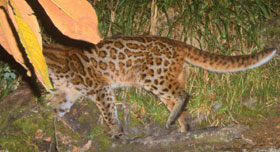
June 11, 2008
Chad Arment, noting this is not really a separate species, despite what the media is reporting, passes along this breaking news from Bhutan’s daily Kuensel Newspaper for June 11, 2008:

A rare morph of the Asiatic golden cat (the ocelot morph) has been sighted in the high altitude mountains of the Jigme Singye Wangchuck national park, which nature conservationists are calling another feather in the cap of Bhutan’s conservation efforts.
The ocelot morph is considered a separate species of wild cat.
Two pictures of the rare ocelot morph were captured by an intensive camera trapping exercise targeted for tigers and leopards in the northern part of the park. According to the chief of nature conservation division (NCD), Dr Sonam Wangyel Wang, the photos were the first of the rare cat caught on camera in the wild. It was captured in the Sephu region at an altitude of 3,738 metres above sea level.
Camera records showed that the pictures dated October 6 and October 9, 2006.
“This is not only the first record of the existence of these cats in high altitude mountains but, for the ocelot morph, it’s the only photo captured in the wild,” said the chief, who presented the pictures to a group of cat specialists in the United Kingdom. “We didn’t know what animal it was and sent it to cat scientists in India and the US for identification. We called it the ‘mystery cat’.”
The only available physical evidence of the ocelot morph was so far from a zoo in China. Its presence in many parts of China was also reported, but no physical evidence was published to support the claim. Dr Sonam Wangyel Wang said the photo from the Chinese zoo was not the best reference for identifying the morph. “The photo from our camera trap is a bit lighter, with a bushy tail, compared with the grayish morph with its tail tipping at the end from the zoo,” he said.
The ocelot morph is known to occur in tropical and sub tropical forests and grasslands. The pictures captured in Bhutan were at the highest altitude. But Dr Sonam Wang said that cat family could easily adapt to different altitudes.
There are about 11 species of cats found in Bhutan of the 36 cat species in the world. The director of NCD, Karma Dukpa, said that the department is proud of the discovery. “It reflects our sound conservation policies,” he said. “When the world is battling to fight extinction of species, we’re discovering new animals. It motivates us to further commit to conservation of our rich biodiversity.”
Dr Sonam Wang added that Bhutan’s conservation polices made the country the best corridor for wildlife. “We are small, but we have a number of rare species of wildlife.” ~ Ugyen Penjore
The ocelot (Leopardus pardalis) is a medium-sized New World cat, distributed over South and Central America and Mexico, but has been reported as far north as Texas and in Trinidad, in the Caribbean. It has a tawny to reddish brown coat marked with black spots and rosettes.
The Asian golden cat (Pardofelis temminckii), also called the Asiatic golden cat and Temminck’s golden cat, is a medium-sized wild cat found throughout Southeast Asia, ranging from Tibet and Nepal to Southern China, India, and Sumatra.
While the Asian golden cat’s fur is mostly foxy red or golden brown, black or grey colour variants may also be found. Normally, the coat is plain, save for some spots on the underside, and sometimes very faint spotting on the rest of the coat. However, in China (and now in Bhutan) there is a colour variant with leopard-like spots, which resembles a leopard cat (Prionailurus bengalensis) of Southeast Asia.
About Loren Coleman
Loren Coleman is one of the world’s leading cryptozoologists, some say “the” leading living cryptozoologist. Certainly, he is acknowledged as the current living American researcher and writer who has most popularized cryptozoology in the late 20th and early 21st centuries.
Starting his fieldwork and investigations in 1960, after traveling and trekking extensively in pursuit of cryptozoological mysteries, Coleman began writing to share his experiences in 1969. An honorary member of Ivan T. Sanderson’s Society for the Investigation of the Unexplained in the 1970s, Coleman has been bestowed with similar honorary memberships of the North Idaho College Cryptozoology Club in 1983, and in subsequent years, that of the British Columbia Scientific Cryptozoology Club, CryptoSafari International, and other international organizations. He was also a Life Member and Benefactor of the International Society of Cryptozoology (now-defunct).
Loren Coleman’s daily blog, as a member of the Cryptomundo Team, served as an ongoing avenue of communication for the ever-growing body of cryptozoo news from 2005 through 2013. He returned as an infrequent contributor beginning Halloween week of 2015.
Coleman is the founder in 2003, and current director of the International Cryptozoology Museum in Portland, Maine.
Filed under Alien Big Cats, Breaking News, Cryptotourism, CryptoZoo News, Cryptozoologists, Cryptozoology, Mystery Cats, New Species, Photos